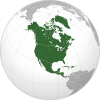Geography of North America
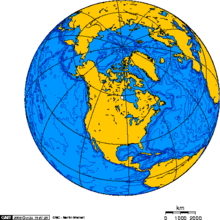
North America is the third largest continent, and is also a portion of the third largest supercontinent if North and South America are combined into the Americas and Africa, Europe, and Asia are considered to be part of one supercontinent called Afro-Eurasia. With an estimated population of 580 million and an area of 24,709,000 km2 (9,540,000 mi2), the northernmost of the two continents of the Western Hemisphere[1] is bounded by the Pacific Ocean on the west; the Atlantic Ocean on the east; the Caribbean Sea on the south; and the Arctic Ocean on the north.
The northern half of North America is sparsely populated and covered mostly by Canada, except for the northeastern portion, which is occupied by Greenland, and the northwestern portion, which is occupied by Alaska, the largest state of the United States. The central and southern portions of the continent are occupied by the contiguous United States, Mexico, and numerous smaller states in Central America and in the Caribbean.
The continent is delimited on the southeast by most geographers at the Darién watershed along the Colombia-Panama border, placing all of Panama within North America.[2][3][4] Alternatively, a less common view would end North America at the man-made Panama Canal. Islands generally associated with North America include Greenland, the world's largest island, and archipelagos and islands in the Caribbean. The terminology of the Americas is complex, but "Anglo-America" can describe Canada and the U.S., while "Latin America" comprises Mexico and the countries of Central America and the Caribbean, as well as the entire continent of South America.
Natural features of North America include the northern portion of the
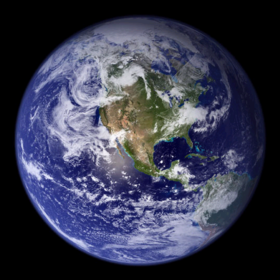
Paleogeography

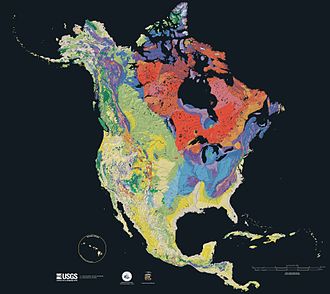
Seventy percent of North America is underlain by the
Roughly 3 million years ago (
North America can also be divided into four great regions:[citation needed]
- the geologically young, mountainous west: including the Rocky Mountains, the Great Basin, California and Alaska;
- the raised but relatively flat plateau of the Canadian Shield in the northeast;
- the varied eastern region: including the Appalachian Mountains, the coastal plain of the
Atlantic Seaboard, and the Florida peninsula.[12]Mexico and its long plateaus and cordilleras fall largely in the western region, although the eastern coastal plain does extend south along the Gulf.

Physiography
North America may be divided into at least five major
- Canadian Shield
- This is a geologically stable area of rock dating between 2.5 and 4 Gya that occupies most of the northeastern quadrant, including Greenland.
- Appalachian Mountains
- The Appalachians are an old and eroded system that formed about 1.3 .
- Atlantic Coastal Plain
- The plain is a belt of lowlands widening to the south that extends from south New England to Mexico.
- Interior Lowlands
- The lowlands extend down the middle of the continent from the Mackenzie Valley to the Atlantic Coastal Plain, and include the Great Plains on the west and the agriculturally productive Interior Plainson the east.
- North American Cordillera
- The cordillera is a complex belt of mountains and associated plateaus and basins some of which were formed as recently as 100–65 Ma, during the Cretaceous. The cordillera extend from Alaska into Mexico and includes two orogenic belts — the Pacific Margin on the west and the Rocky Mountains on the east — separated by a system of intermontane plateaus and basins.[10]
The Coastal Plain and the main belts of the North American Cordillera continue in the south in Mexico (where the Mexican Plateau, bordered by the Sierra Madre Oriental and the Sierra Madre Occidental, is considered a continuation of the intermontane system) to connect the Transverse Volcanic Range, a zone of high and active volcanic peaks south of Mexico City.
The vast majority of North America is located on the North American Plate, centered on the Laurentia craton. Parts of California and western Mexico form the partial edge of the Pacific Plate; the two plates meet along the San Andreas Fault. The southern portion of the Caribbean and parts of Central America compose the much smaller Caribbean Plate.
The western mountains have split in the middle, into the main range of the Rockies and the Coast Ranges in California,
Three countries (Canada, the United States, and Mexico) make up most of North America's land mass; they share the continent with 34 other island countries in the Caribbean and south of Mexico.
Geographic center of North America
The geographic center of North America is near Center, North Dakota,[14] according to Peter Rogerson, geography professor at the University at Buffalo, who published a new method of calculating geographical centers.[15]
Earlier placements in 1931 involved geographers balancing a cardboard cutout of a region on a needlelike point to find its center to establish a spot "6 miles west of Balta, Pierce County, North Dakota",[14] at 48⁰ 10′north, 100⁰ 10′west.[16] In 1932, a field stone cairn recognizing this was erected in nearby Rugby, North Dakota at the intersections of U.S. Route 2 and ND State Highway 3.[17][18][19]
Surface and climate
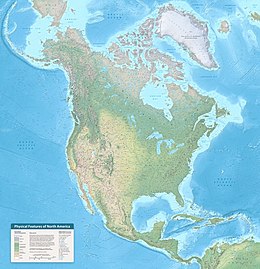
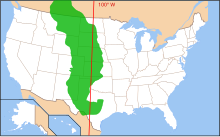
The
North America extends to within 10° of latitude of both the equator and the North Pole. It embraces every climatic zone, from tropical rain forest and savanna on the lowlands of Central America to areas of permanent ice cap in central Greenland.[20] Subarctic and tundra climates prevail in north Canada and north Alaska, and desert and semiarid conditions are found in interior regions cut off by high mountains from rain-bearing westerly winds.[12] However, most of the continent has temperate climates very favorable to settlement and agriculture. Prairies, or vast grasslands cover a huge amount in mountain ranges.[12]
North America's greatest snowfalls
| Places | Date | Inches | Centimeters | |
|---|---|---|---|---|
| 24 hours | Silver Lake, Colorado | April 14–15, 1921 | 76 | 195.6 |
| 1 month | Tamarack, California | January 1911 | 390 | 991 |
| One storm | Mt. Shasta Ski Bowl, Calif. | February 13–19, 1959 | 189 | 480 |
| One season | Mount Baker, WA | 1998–1999 | 1, 140 | 2, 895.6 |
Hydrography and deserts
The average
River systems

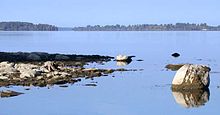


Listed below by watershed are some of the more notable rivers in North America. Rivers flow entirely within the United States, unless otherwise noted.[23]
- Atlantic Ocean watershed
- Churchill River (Atlantic) 856 mi (1,378 km) (in Canada)
- Churchill River (Hudson Bay) 1,000 mi (1,600 km), flows to Hudson Bay and then connects to Labrador Sea and Atlantic Ocean (in Canada)
- Connecticut River 410 mi (660 km)
- Delaware 301 mi (484 km)
- Hudson River 315 mi (507 km)
- James River (Virginia)348 mi (560 km)
- Potomac River 405 mi (652 km)
- Savannah River 301 mi (484 km)
- Susquehanna River 444 mi (715 km)
- St. Johns River 310 mi (500 km)
- St. Lawrence River 310 mi (500 km)
- Atlantic Ocean through the Caribbean Sea
- Artibonite River 199 mi (320 km) (in Haiti and Dominican Republic)
- Cauto River 230 mi (370 km) (in Cuba)
- Atlantic Ocean through the Gulf of Mexico watershed
- Allegheny River 325 mi (523 km)
- Arkansas River 1,469 mi (2,364 km)
- Brazos River 1,352 mi (2,176 km)
- Grijalva River 300 mi (480 km) (in Mexico)
- Mississippi 2,320 mi (3,730 km)
- Missouri River 2,321 mi (3,735 km)
- Ohio River 981 mi (1,579 km)
- Pecos River 926 mi (1,490 km)
- Red River of the South 1,360 mi (2,190 km)
- Tennessee River 652 mi (1,049 km)
- Rio Grande 1,896 mi (3,051 km) (in Mexico and U.S.)
- Usumacinta River 620 mi (1,000 km) (in Guatemala and Mexico)
- Arctic Ocean watershed
- Albany River (in Canada) 610 mi (980 km)
- Mackenzie River 2,635 mi (4,241 km) longest river in Canada, (flows through the Beaufort Sea in Canada)
- Nelson River 1,600 mi (2,600 km) (in Canada)
- Severn River (northern Ontario)982 mi (1,580 km) (in Canada)
- Saint John River (New Brunswick)(in Canada)
- Pacific Ocean watershed
- Balsas River (in Mexico)
- Columbia River
- Fraser River (in Canada)
- Lerma River (in Mexico)
- Sacramento River
- San Joaquin River
- Snake River 1,078 mi (1,735 km)
- Suchiate River (in Guatemala and Mexico)
- Yukon River (in Canada and U.S.)
- Pacific Ocean through the Bering Sea
- Kuskokwim River 702 mi (1,130 km)
- Pacific Ocean through the Gulf of California
- Colorado River 862 mi (1,387 km) (Mexico and U.S.)
- Fuerte River (in Mexico)
- Great Basin watershed (does not reach oceans)
- Bear River 350 mi (560 km)
- Humboldt River 290 mi (470 km)
- Sevier River 385 mi (620 km)

Climate and vegetation
There are various plant life distributions in North America. Plant life in the Arctic includes grasses, mosses, and Arctic willows. Coniferous trees, including
Deserts
The Sierra Nevada and Cascade mountain ranges run along the entire
| Major habitat types of the United States and Canada | Ecoregions map of Canada, United States and Mexico |
|---|---|
 |
 |
Zoology
North America is home to many native mammal species. Several species of
Mining and petroleum
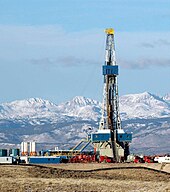
The mining and petroleum industries are important in Canada, the United States and Mexico. These natural resources make the region one of the richest on the earth.[1][24]
Rocky Mountains
The Rocky Mountain region is known for vast resources and rich mineral deposits including copper, lead, gold, silver, tungsten or Wolfram, uranium, zinc and Coal, petroleum and natural gas are mineral fuels found.[1][24] Old mine tailings are present in the Rocky Mountain landscape.
Agriculture and forestry
Agriculture and forestry are two major industries. Agriculture includes arid land and irrigated farming and livestock grazing.[1] Livestock are often moved between high-elevation summer pastures and low-elevation and winter pastures.
See also
- Geography of North America
- Geography of Canada
- Geography of the Caribbean
- Geography of Anguilla
- Geography of Antigua and Barbuda
- Geography of Aruba
- Geography of Barbados
- Geography of Bonaire
- Geography of the British Virgin Islands
- Geography of the Cayman Islands
- Geography of Cuba
- Geography of Curaçao
- Geography of Dominica
- Geography of the Dominican Republic
- Geography of Grenada
- Geography of Guadeloupe
- Geography of Haiti
- Geography of Jamaica
- Geography of Martinique
- Geography of Montserrat
- Geography of Puerto Rico
- Geography of Saba
- Geography of Saint Barthélemy
- Geography of Saint Kitts and Nevis
- Geography of Saint Lucia
- Geography of Saint Martin
- Geography of Saint Vincent and the Grenadines
- Geography of Sint Eustatius
- Geography of Sint Maarten
- Geography of Trinidad and Tobago
- Geography of the United States Virgin Islands
- Geography of Central America
- Geography of Greenland
- Geography of the Lucayan Archipelago
- Geography of the Bahamas
- Geography of the Turks and Caicos Islands
- Geography of Mexico
- Geography of the United States
- Geology of North America
- List of mountain peaks of North America
- List of rivers of the Americas by coastline
- Transportation in North America
Notes
- ^ a b c d "Geographic Guide - Images of North America". Retrieved October 11, 2006.
- ^ "Americas" Standard Country and Area Codes Classifications (M49), United Nations Statistics Division
- ^ "North America" Archived October 21, 2006, at the Wayback Machine Atlas of Canada
- ^ North America Atlas National Geographic
- ^ "United Plates of America". Smithsonian Museum of Natural History. Retrieved on 2009-01-31.
- ^ Thompson, Andrea (2008-09-25). "Oldest rocks on Earth found". NBC News. Retrieved 2009-02-01.
- .
- ^ Brahic, Catherine (2008-09-26). "Discovery of world's oldest rocks challenged". New Scientist. Retrieved 2009-02-01.
- ^ "Rodinia" Archived 2009-02-18 at the Wayback Machine (2005). Palæos. Retrieved on 2009-02-01.
- ^ a b Jones, Steve. "North America's Geology and Geography". USA Today. Retrieved August 19, 2006.
- ^ "Historical & Cultural Significance" (1995). Bering Land Bridge Natural Preserve.
- ^ a b c d "Encyclozine - North America". Retrieved October 11, 2006.
- ^ Thomas, William A.; Hatcher, Jr., Robert D. (2021). "Southern-Central Appalachians-Ouachitas Orogen". Encyclopedia of Geology. 4 – via Elsevier Science Direct.
The foundations of the Appalachian-Ouachita orogen were laid when the assembly of supercontinent Rodinia was completed. The collisional events were accompanied by high-grade metamorphism and magmatism during the Grenville orogeny in the time span of 1300–950 Ma.
- ^ a b Yin, Steph (January 25, 2017). "North America's Geographical Center May Be in a North Dakota Town Called Center". The New York Times. Retrieved December 30, 2018.
- .
- ^ "Elevations and Distances in the United States". 1995. Archived from the original (Online Edition) on July 22, 2012. Retrieved February 5, 2009.
No marked or monumented point has been established by any government agency as the geographic center of the 50 States, the conterminous United States, or the North American continent.
- ^ Daley, Jason (January 30, 2017). "New Calculations Reposition the Geographical Center of North America". Smithsonian. Retrieved August 9, 2021.
- ^ Bhagat, David (May 30, 2021). "The debate over the Geographical Center of North America". CBS News. Retrieved August 9, 2021.
- ^ "About Us". Rugby Chamber of Commerce. Retrieved August 9, 2021.
- ^ a b "North America climate". Retrieved August 19, 2006.
- ^ "Private Tutor". Infoplease.com. April 11, 2004. Retrieved June 30, 2010.
- ^ North America water resources.
- USGSGNIS database.
- ^ a b "Fact Monster - North America: Resources and Economy". Retrieved October 11, 2006.
References
- "Deserts of America". The Golden Treasury of Knowledge. book 13. Vol. 4. Fratelli Fabbri. 1961. pp. 1008–1091. 61-10594.
- "Geography of North America". Universal World Reference Encyclopedia. book 1. Vol. 11. V.S. Thatcher. 1964. pp. 231–233. 64-12955.
Bibliography
Map and aerial photos
- North America map
- Physical map
- Map of the Great Lakes Archived July 27, 2021, at the Wayback Machine
- North American map
- North America Political map
- Oldest Human Remains in North America Found
- T. H. Clark and C. W. Stearn, The Geological Evolution of North America (1968)
- W. P. Cumming et al., The Discovery of North America (1972)
- R. C. West et al., Middle America: Its Lands and Peoples (3d ed. 1989)
- T. L. McKnight, Regional Geography of the United States and Canada (1992)
- S. Birdsall, Regional Landscapes of the United States and Canada (4th rev. ed. 1992)
- T. Flannery, The Eternal Frontier: An Ecological History of North America and Its Peoples (2001)
- A. Taylor, American Colonies (2001).

